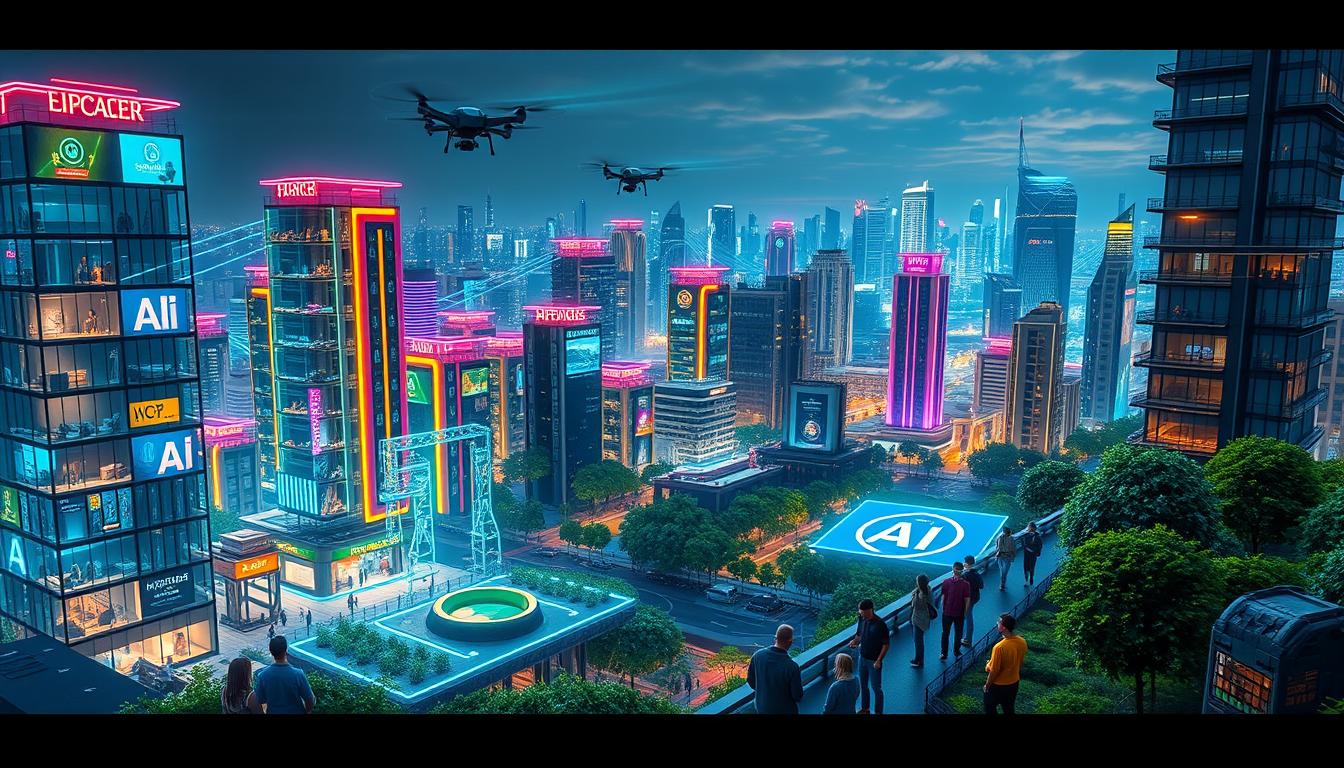7 Innovative AI Ideas for the Future

7 Innovative AI Ideas for the Future: AI technology is changing fast, bringing new ideas to the table. It’s transforming how we live and work. AI has endless possibilities, and exploring new ideas is key to moving forward.
New AI concepts are being used in many areas, making a big difference. As AI keeps getting better, it’s important to keep up with the latest news. In this article, we’ll look at the most exciting AI ideas that will change the future.
Key Takeaways
- AI technology is rapidly evolving and has the power to change many industries.
- New AI ideas are being used in different fields, making a big impact.
- Exploring new AI concepts is important for progress and making life better.
- AI can shape the future, changing how we live and work.
- The effects of new AI ideas will be big, and staying updated is key.
- AI technology and new ideas will keep getting better in the years to come.
Understanding the Current State of Artificial Intelligence
Artificial intelligence has seen big changes over time, thanks to AI advancements and the drive for new ideas. Looking at AI today, we see how far it’s come and its role in the future of AI. AI’s journey includes key moments, like the start of machine learning and the making of smart systems that can do hard tasks.
AI tech has grown fast, with big steps forward in recent years. It’s made a big difference in healthcare, finance, and transport. For example, AI helps doctors look at medical images, find diseases, and plan treatments. In finance, AI spots fraud, guesses market trends, and makes investment plans better.
The Evolution of AI Technology
AI’s growth comes from better computers, more storage, and smarter learning algorithms. These changes have led to advanced AI systems that can learn, think, and talk to people. As AI keeps getting better, we’ll see new uses in many fields.
Key Milestones in AI Development
- Development of machine learning algorithms
- Creation of intelligent systems capable of performing complex tasks
- Advancements in natural language processing and computer vision
Present-Day AI Applications
AI is used in many areas, like healthcare, finance, transport, and education. It helps make things more efficient, accurate, and smart. Thinking about the future of AI, we must look at both the good and the challenges it brings to our lives.
The current AI scene shows how fast humans can innovate and progress in this field. As we explore what AI can do next, we must also think about its ethics. We need to make sure these AI advancements help society.
| Industry | AI Application |
|---|---|
| Healthcare | Disease diagnosis and treatment |
| Finance | Fraud detection and investment portfolio optimization |
| Transportation | Autonomous vehicles and route optimization |
Artificial Intelligence Ideas for Future Implementation
Exploring artificial intelligence opens up many exciting possibilities. AI can change many areas, from education to entertainment. For example, AI can make learning more personal and fun for students.
In entertainment, AI can suggest content just for you. It can also help protect our environment by tracking climate change. Investing in AI research is key to making these ideas real and improving our future.
Some cool AI ideas include:
- Intelligent virtual assistants that can do things on their own
- AI in healthcare that can find and treat diseases better
- Smart home devices that get to know what you like
By using AI, we can make the world better, more efficient, and connected. We need to keep working on AI research. This way, we can make sure AI helps everyone, not just a few.
Neural Interface Integration: Merging Mind and Machine
Neural interface integration is a hot topic, promising to change how we interact with machines. It uses a neural interface for direct brain-computer interaction. This lets people control devices with their thoughts.
In therapy, neural interfaces are a game-changer. They help those with paralysis or motor disorders talk better. They also treat conditions like epilepsy and depression.
The benefits of neural interface integration are many:
- Improved communication for people with disabilities
- Enhanced treatment options for neurological conditions
- Potential for new educational possibilities, such as brain-computer interface-based learning systems
As research grows, we’ll see more uses for neural interfaces. This tech could change how we interact with machines, making it a key part of AI.
Neural interfaces could make our lives better in many ways. They could improve communication, education, and offer new treatments. As this tech evolves, it will be exciting to see its impact.
| Application | Description |
|---|---|
| Therapeutic Treatments | Neural interfaces can be used to treat a range of neurological conditions, such as epilepsy and depression. |
| Education | Brain-computer interface-based learning systems can provide new educational possibilities. |
| Communication | Neural interfaces can improve communication for people with disabilities. |
Quantum AI Computing Systems
Quantum AI computing is a new tech that mixes quantum computing and AI. It makes AI systems better at handling complex data. This tech can solve problems that old computers can’t, which is why it’s so exciting.
Quantum AI works by handling lots of data at once. This is thanks to superposition and entanglement. It lets AI systems learn and get better really fast. This is great for tasks like machine learning and natural language processing.

- Enhanced predictive analytics for businesses and organizations
- Improved cybersecurity measures to protect against complex threats
- More efficient optimization of complex systems and processes
As quantum AI computing grows, we’ll see new uses for it. It’s changing AI in big ways. This makes it a very promising field for the future.
Autonomous Creative AI Platforms
Autonomous creative AI is changing how we see art and design. It can come up with new ideas and concepts. This autonomous creative AI boosts human creativity and opens up new possibilities. It’s used in music, literature, and more, creating unique and innovative works.
In art and design, AI makes amazing visual effects and designs. AI in art and design lets artists try new styles and techniques. It also creates complex designs that humans can’t do alone. For instance, AI art has sold at auctions, and AI-designed products are used in many industries.
- Increased efficiency and productivity
- Improved accuracy and attention to detail
- Enhanced creativity and innovation
But, there are also challenges with autonomous creative AI. There’s a risk of jobs being lost and the need for new skills. As AI grows, we must tackle these issues. We need to make sure everyone benefits from this technology.
| Application | Description |
|---|---|
| Music Composition | AI is being used to create original music compositions, from classical to pop |
| Literary Creation | AI is being used to generate original stories, poems, and other forms of written content |
| Art and Design | AI is being used to create stunning visual effects and designs, from graphic design to architecture |
Environmental Management Through AI
Environmental management is key to sustainability, and AI is a big help. It lets organizations look at big data and learn from it. Environmental management means saving natural resources, cutting down on waste, and reducing pollution. AI tools can make these tasks better.
AI can help in many ways, like:
- Predictive analytics to forecast environmental changes and identify areas of high conservation value
- Real-time monitoring of environmental parameters, such as air and water quality
- Optimization of resource allocation and reduction of waste
Using AI for sustainability, companies can lessen their impact on the environment. 
As environmental management grows, AI will play a bigger role. With AI, we can make our world more sustainable and green.
Biomedical AI Breakthroughs
Biomedical AI is changing healthcare by finding new ways to diagnose and treat diseases. It helps doctors create treatment plans that fit each patient’s needs. AI-powered systems look through lots of medical data to find patterns and predict how patients will do.
AI is also helping prevent diseases. It looks at big datasets to find patients at high risk. This lets doctors act early, which can prevent serious problems and make patients healthier.
Personalized Medicine Development
AI is big in personalized medicine. It uses genetic data, medical history, and lifestyle to make treatment plans for each person. This is very promising for complex diseases like cancer, where AI-driven analysis finds the best treatments.
Disease Prevention Systems
AI is also great for preventing diseases. It looks at big datasets to spot patterns and predict risks. This means doctors can catch problems early, which helps patients avoid serious issues. For example, AI can look at health records to find people at risk for diseases like diabetes or heart disease.
Genetic Engineering Applications
AI is also helping in genetic engineering. It analyzes genetic data to find genetic disorders and create treatments. This is showing promise for diseases like sickle cell anemia and cystic fibrosis. AI in genetic engineering could change the field, leading to better treatments and outcomes.
AI-Driven Space Exploration
AI is changing how we explore space. Space technology lets spacecraft move through space better. AI looks at lots of data, helping us make smart choices.
AI has many uses in space travel. Here are a few:
- Spacecraft navigation: AI helps spacecraft avoid dangers and find the best paths.
- Planetary exploration: AI studies data from space probes. This helps us learn about other planets.
- Astronaut assistance: AI helps astronauts with their work, like checking life support systems.

As AI-driven space exploration grows, we’ll see more amazing things. AI could help us explore far-off planets and galaxies. We’ll discover new things about the universe.
Ethical Considerations and Regulatory Frameworks
As AI technology grows, we must tackle its ethical sides and rules. Ethical considerations are key to making sure AI helps everyone. We must think about privacy, safety, and who’s accountable.
Setting up rules for AI is important to avoid risks. These rules help make AI systems clear, fair, and open. AI governance means making and following policies for AI use.
Some key parts of AI governance include:
- Privacy concerns: keeping personal data safe and stopping misuse
- Safety protocols: making sure AI systems don’t cause harm
- International cooperation: working together worldwide for AI standards
By focusing on ethics and rules, we can use AI wisely. This way, everyone can benefit from it.
The aim of AI governance is to make AI that fits human values and helps society. By focusing on ethics and rules, we can make AI’s future bright for everyone.
| Aspect | Importance | Challenges |
|---|---|---|
| Privacy concerns | High | Misuse of personal data |
| Safety protocols | High | Accidents and harm |
| International cooperation | Medium | Establishing common standards |
Conclusion: Shaping the Future of AI Technology
The future of AI technology is full of possibilities. It could merge our minds with machines and use quantum computing. These advancements will change our world in amazing ways.
AI will make huge strides in many areas. It will help us find new medicines and explore space. The future looks bright and full of promise.
But we must think about the ethics of AI. We need strong rules to protect our privacy and safety. This will help AI help us, not harm us.
We should keep investing in AI research. We must find a balance between new tech and doing the right thing. The choices we make today will shape the future of AI.
FAQ
What is the current state of artificial intelligence (AI) technology?
AI has grown a lot over the years. It started with machine learning and natural language processing. Now, it’s used in many fields like healthcare and finance.
What are some innovative AI ideas for the future?
Future AI ideas include neural interfaces and quantum AI. They aim to connect humans with machines and use quantum physics. AI will also create art and explore space.
How can AI be used for environmental management?
AI can help the environment by analyzing data and predicting problems. It can track climate change and manage resources. This makes it easier to find solutions for sustainability.
What are the ethical considerations surrounding AI development?
AI raises concerns about privacy and safety. It’s important to have rules for its use. This ensures AI is developed responsibly and fairly.
How can AI contribute to advancements in biomedical research?
AI is changing medicine by analyzing health data. It helps find new treatments and understand diseases better. This leads to more accurate care for each person.
What is the potencial of AI in space exploration?
AI is key in space travel, helping with navigation and tasks for astronauts. It makes space missions safer and more efficient. This opens up new areas for space exploration.




